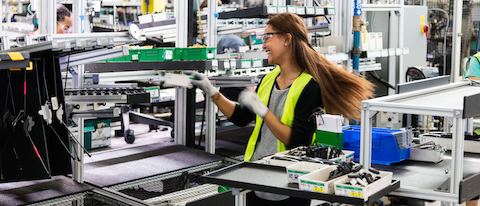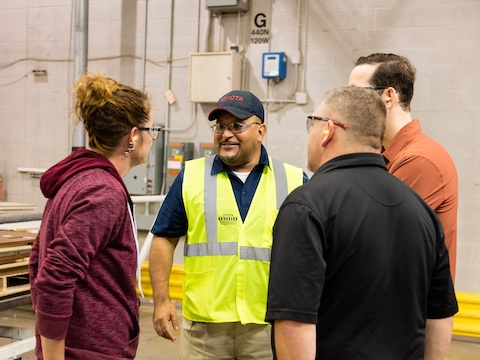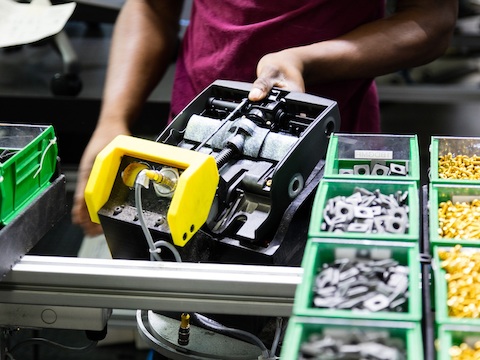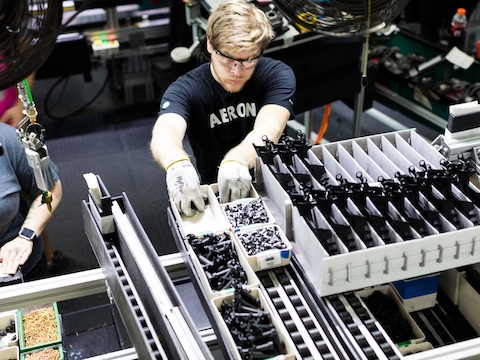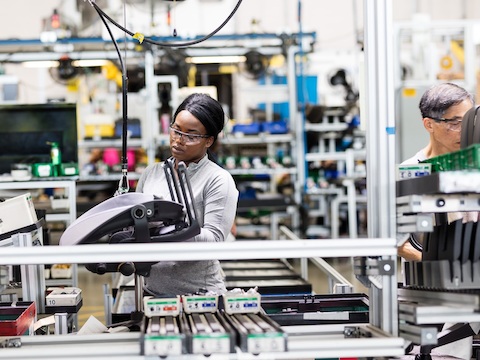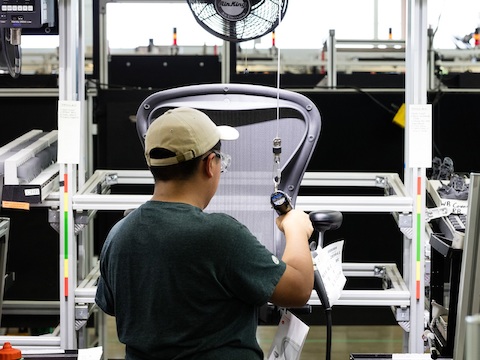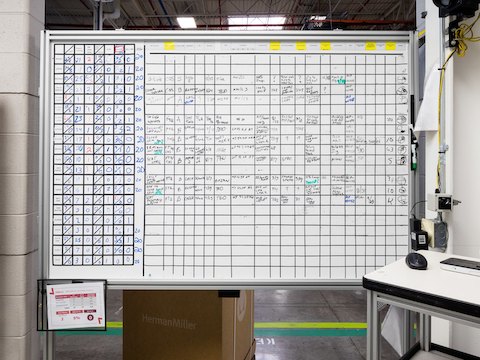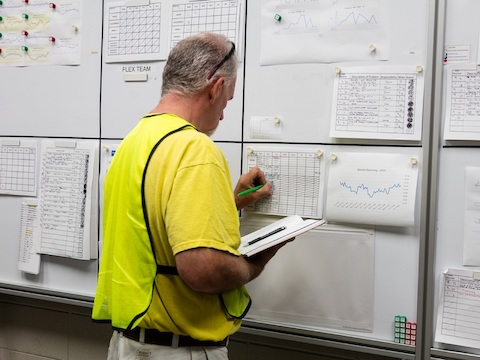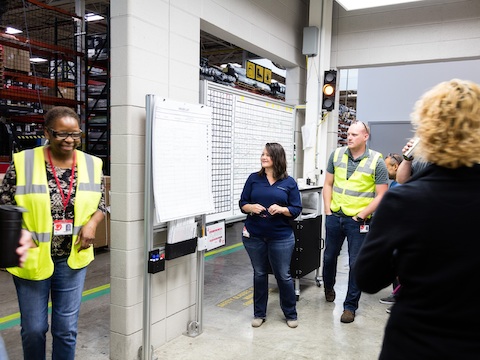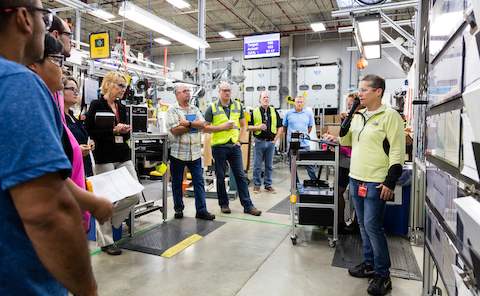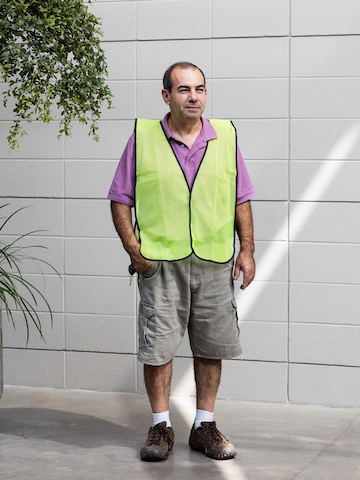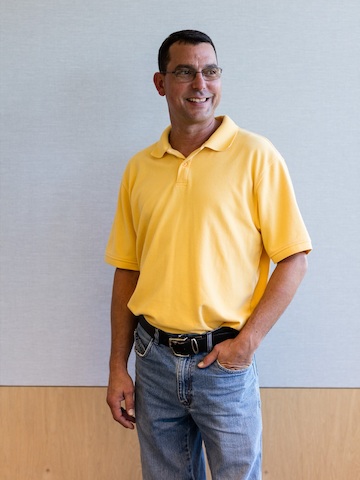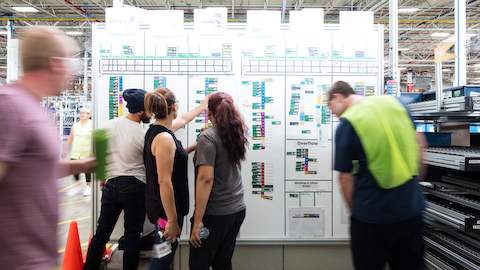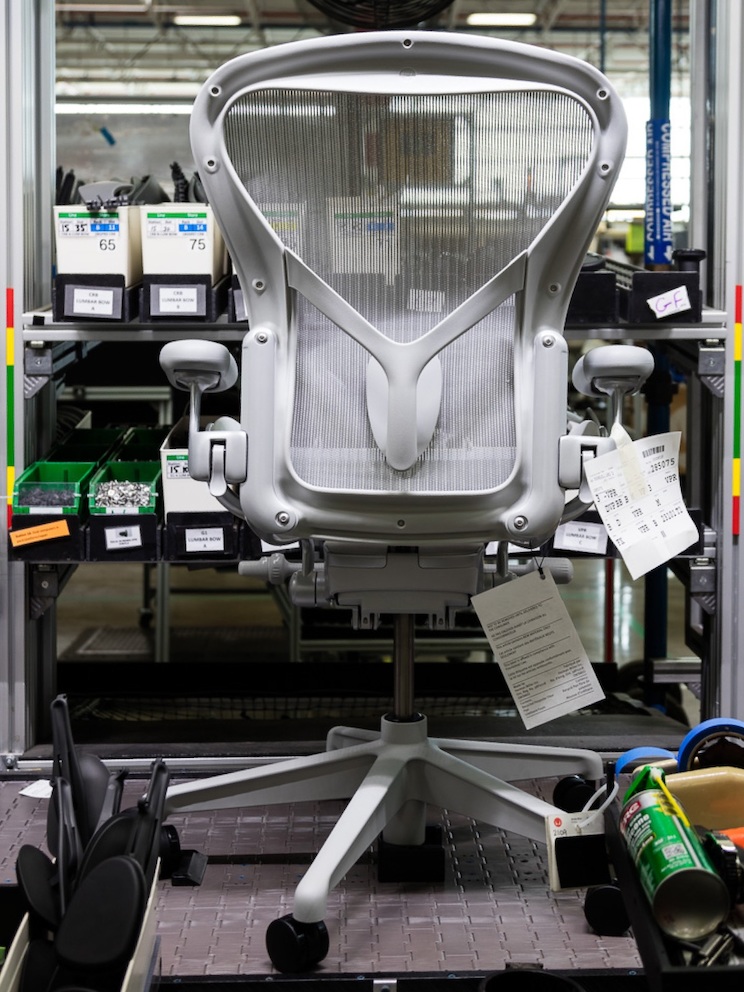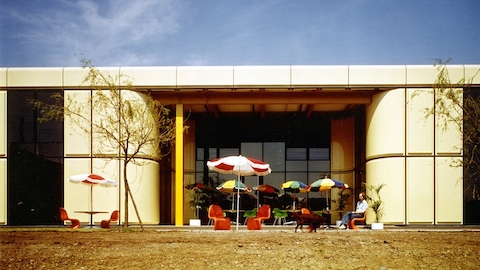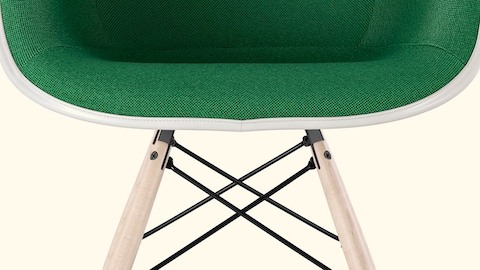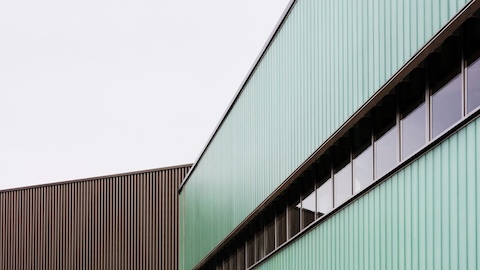The 1990s economic boom was good news for Herman Miller, but bad news for our filing cabinet plant in Spring Lake, Michigan. The facility, called IMT (Integrated Metal Technologies), was already having a hard time keeping pace with growing customer demand for its products. In response, corporate leadership offered a bit of tough love: either reduce lead times by 70 percent and price points by 30 percent, or face outsourcing and layoffs.
We needed a radical idea. And we found one just up the road—by way of Aichi Prefecture, Japan.
An automotive parts supplier in nearby Grand Haven, Michigan, was engaged with Toyota to learn the secrets of Toyota Production System (TPS), the automaker’s renowned just-in-time manufacturing process. Herman Miller got in touch, then got a company-altering invitation.
Matt Long, now our Vice President for Continuous Improvement, was one of two IMT team members invited by that Grand Haven company to spend six months observing TPS in action. What he saw blew him away: a smooth, even flow of made-to-order products; no excess inventory cluttering the facility; a highly visual work environment in which problems were evident and addressed in real time; no mistakes covered up or flagged to be fixed later; all orders fulfilled complete and on-time; no scrambling or working overtime to catch up.
“We were pretty skeptical at first,” Long recalled. “But the longer we were there—and the longer we were exposed to Toyota—we became really convinced this was going to be exactly what we needed.”
When Long returned, IMT immediately began implementing TPS ideas, and many small but meaningful gains were made. More importantly, the exercise caught the attention of Hajime Ohba, then the top executive at the Toyota Supplier Support Center (TSSC). Impressed by our willingness to invest in learning their system, TSSC accepted Herman Miller as a project company in 1996.
Five years of on-site TPS training followed. Lead times fell and quality skyrocketed, all without the need for major capital investment. And despite all the productivity gains made, IMT employees kept their jobs.
Jim McPherson, who today is a Continuous Improvement Leader at our GreenHouse manufacturing facility, remembers the buzz that began swirling around IMT’s success with Toyota during the mid-1990s. “IMT suddenly became that part of the company that leadership came to saying, ‘What’s going on there? How can we scale this?’” he said.
One of those leaders was Herman Miller CEO Brian Walker. At the time, Walker served as President for North American operations. “Not only was the system making the work better for our people,” Walker recalled, “but as a result of the changes, we also began producing higher quality products—and doing so more reliably, resulting in great customer outcomes and better economic returns. So in 1999, we decided to use the same methodology across all of Herman Miller.”
That’s how an idea introduced at a facility in crisis became the new standard for a global manufacturer—all within five years. Such a rapid and successful adoption of the Toyota Production System is noteworthy, according to Jeffrey Liker, Professor Emeritus in the Industrial and Operational Engineering Department at the University of Michigan and author of the book The Toyota Way: 14 Management Principles from the World's Greatest Manufacturer.
“Toyota doesn’t have a 100 percent success rate with TSSC clients folding the process into their culture,” Liker said. “A good number of project companies peter out over time—and even among companies that do stick with TPS, few are the size of Herman Miller, and fewer still have adopted lean practices across so much of their organization.”
Further, not only had the TPS principle of Kaizen—continuous improvement—spread to all of our manufacturing facilities, we also applied it to the Toyota Production System itself. By 1998, our continuously improving version of TPS had evolved into something unique to Herman Miller. Our version of TPS became known as “HMPS,” or the Herman Miller Performance System.
“We think it’s great that Herman Miller has internalized the system and that you’ve defined it for yourselves,” said Jaime Bonini, Toyota’s Vice President of TSSC. “Your values as a company predate any work with us. You already had a deep belief in value of your employees. What we’ve done was add to that the foundation of the high-performing operations you have built today.”
Of course, the elephant in the factory with most attempts at lean manufacturing is the fear that becoming more efficient will eventually mean employing fewer workers. But our HMPS journey has actually proven that the opposite can be true. Not only has HMPS kept our US factories competitive, but it also has provided a path for the growth and development of the people who work there.
HMPS has done more than simply protect jobs. It’s created new, high-value jobs that wouldn’t exist without it. Agustin Coronado’s job is one of them.
Coronado, who joined Herman Miller in 1994, was one of the original facilitators on the Aeron Chair line. He observed how operators were straining to grab chair bases from a conveyance cart and place them on the line. A tinkerer since his childhood, Coronado worked with our model shop to devise a new method for delivering bases to the line—one that not only reduced strain, but also shaved time off the Aeron assembly process.
Other facilitators began seeking Coronado out, asking him to build similar carts for their lines. Supervisors took note and promoted him to Fabricating Technician. Today, building carts, racks, and other mechanisms to deliver parts and packaging materials more efficiently and ergonomically is his full-time job.
“HMPS pretty much teaches you to look for ways to remove the waste,” Coronado said—that means wasted effort as well as wasted time. “I do what I can to make other people’s jobs easier.”
Like Coronado, Pierre Fowler works to find ways to help our manufacturing team remove waste from their workflow. He just works further upstream. Fowler spent time working on the Aeron line in the mid-2000s, where his knack for problem-solving caught the attention of supervisors. By 2010, they assigned him to a new product line that offered plenty of problems to solve.
The Sayl Chair was set to launch, but we needed to figure out a better way to attach its elastomeric backrest to its frame. In the prototyping stage, it took two operators more than one minute to complete that step. “We couldn’t go into production like that,” Fowler said. He and his fellow operators provided valuable input as our HMPS team refined the Sayl assembly process, and soon one operator could attach the backrest in less than 15 seconds without assistance.
Recognizing the value of Fowler’s feedback, the HMPS team developed a new role—Advanced Manufacturing Lead—dedicated to keeping design-for-manufacture at the fore throughout product development. Then they hand-picked Fowler to fill it. “I didn’t even ask what it was,” Fowler remembered. “I said, ‘Sign me up.’ I had been looking for an opportunity to move up within the company.”
A life preserver in a time of crisis, a ladder to growth and opportunity: HMPS has meant a lot to Herman Miller over the last 20 years. Looking ahead to the next 20, however, the most apt metaphor might simply be a clear path forward.
As offices become less uniform, they require a wider variety of furniture. The days when a furniture company could outfit a corporate headquarters with hundreds or even thousands of the same thing? They’re gone. So, to help us meet the demands of business today, we’ve re-engaged with Toyota.
“When you look at this new type of business—high product mix, extremely high variety, low volumes—it just happens to be something Toyota is very good at,” Matt Long explained. “That’s their market in Japan; it’s smaller, but they have to offer everything. So, they’re actually back on-site teaching us how to better adjust our process for these changes.”
Today, whether we’re working with dealers on the last mile of our customer journey, introducing HMPS to new operators on an assembly line, or thinking through the office of tomorrow, HMPS is constantly in play. Yes, it’s our approach to lean manufacturing. More precisely, it’s how we continuously improve at Herman Miller by identifying problems and working together to solve them.
“If we work to do a better job of designing spaces around the needs of people, we know we’ll get better outcomes. But we’ll also reduce the friction that people have as they move throughout their day and eliminate wasted energy, wasted time and frustration, human struggle,” Walker said. “That is a very HMPS idea.”
